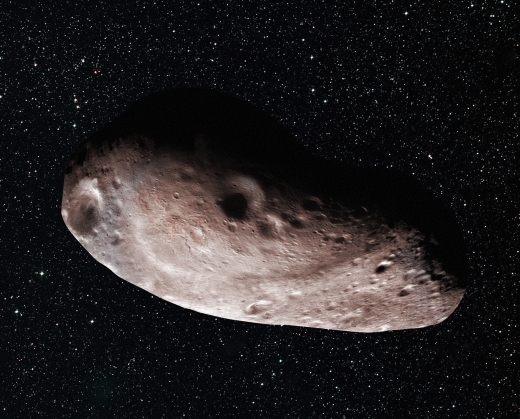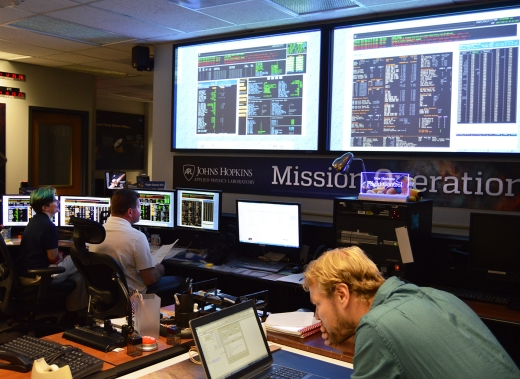If New Horizons can make its flyby of Kuiper Belt Object MU69 at a scant 3500 kilometers, our imagery and other data should be much enhanced over the alternative 10,000 kilometer distance, one being kept in reserve in case pre-encounter observations indicate a substantial debris field or other problems close to the object. But both trajectories, according to principal investigator Alan Stern, have been moved closer following a ten-week study period, and both are closer than the 12,500 kilometers the spacecraft maintained in its flyby of Pluto.

Image: Artist’s concept of Kuiper Belt object 2014 MU69, which is the next flyby target for NASA’s New Horizons mission. Scientists speculate that the Kuiper Belt object could be a single body (above) with a large chunk taken out of it, or two bodies that are close together or even touching. Credit: NASA/Johns Hopkins University Applied Physics Laboratory/Southwest Research Institute/Alex Parker.
Stern made the statement in early September at a meeting of the Outer Planets Assessment Group (OPAG), in which he also pointed out that flyby observations of the distant KBO will commence in August of next year in preparation for the early January arrival in 2019. The process of returning acquired data to Earth is estimated to take up to 20 months.
We also get this heartening news: Stern considers the Kuiper Extended Mission of New Horizons to be ‘multi-pronged,’ with the January 1 flyby of MU69 perhaps the prelude to further operations. New Horizons has sufficient fuel and power to operate until roughly 2035, and the downlink of MU69 data will end in September of 2020. The current extended mission was approved for the period 2016-2021. Will there be another?
According to Stern’s presentation at OPAG, the current extension involves not just the flyby of MU69, along with heliospheric plasma, dust, and neutral gas observations in the Kuiper Belt, but also distant observations of up to 30 other KBOs and numerous Centaurs. These studies involve searches for satellites, rings and dust along with examination of KBO light curves and shapes, with numerous papers on these results said to be in early stages of preparation.
With enough power and fuel to make it well into the 2030s, New Horizons, which is after all the only spacecraft with the opportunity to make these observations, could continue its active work for many years. An extended mission from 2021 to 2024 would allow additional KBO flyby search time for future targets as well as continuing Kuiper Belt observations.
And on the question of what happens after New Horizons, Stern’s presentation at OPAG included the possibility of a Pluto orbiter, which is already being studied at SwRI, Ball Aerospace, Lockheed-Martin and NASA GSFC. A tantalizing thought, that.
Jeff Foust quotes Stern in The Space Review as saying this:
“I think New Horizons has a bright future, continuing to do planetary science and other applications. There’s fuel and power onboard the spacecraft to operate it for another 20 years. That’s not going to be a concern even for a third or fourth extended mission.”

Image: Flight controllers (from left) Katie Bechtold, Ed Colwell and Jon Van Eck, working in the mission operations center at the Johns Hopkins Applied Physics Laboratory in Laurel, Maryland, confirm data indicating that the New Horizons spacecraft had safely exited hibernation on Sept. 11, 2017. Credit: NASA/Johns Hopkins University Applied Physics Laboratory/Southwest Research Institute.
Meanwhile, New Horizons ‘awakened’ from a five-month hibernation period on September 11, being brought over the next three days into active mode, in which science instrument checkouts and data collection activities can resume, to be continued until mid-December. From the latest JHU/APL news update outlining the course of the coming months:
The spacecraft will train its instruments on numerous distant KBOs, making long-distance observations with the telescopic Long Range Reconnaissance Imager (LORRI), while also continuously measuring the Kuiper Belt’s radiation, dust, and gas environment. The team also will test the spacecraft’s instruments in preparation for next year’s approach to MU69, and transmit a new suite of fault-protection software – also known as autonomy software – to New Horizons’ computer in early October.
On December 22, New Horizons again goes into hibernation, to be awakened on June 4, 2018, at which point preparations for the MU69 approach will go into high gear. The spacecraft is currently 3.89 astronomical units (AU) from MU69 as Kuiper Belt exploration continues.



The one down side to extra KBO missions is that the transmission and storage of the contents from One Earth Message will be delayed even longer, increasing the risk that it won’t happen at all.
https://centauri-dreams.org/?p=38453
One lousy reproduction of the Pioneer Plaque placed on the probe would have been sufficient. They had time to go through the process of putting Clyde Tombaugh’s ashes on New Horizons, so they certainly could have attached one plaque that already existed.
http://www.collectspace.com/news/news-102808a.html
Never again. ALL deep space probes must have information packages attached to them describing the species that made them, where they came from, and the purpose of the mission if possible on that last one. No more excuses. We don’t know who or what is out there. Plus if our descendants find them they will appreciate the historical data of their ancestors. Just ask any historian who has to work with fragments of an ancient culture.
Columbus ships had no plaques. We should be much more occupied in continuing exploration and starting settlement than in sending messages in bottles. Sending messages in every probe we launch is a very unambitious and depressing goal, with its implication that we don’t think probable that we’ll extend beyond Earth.
Two major misinterpretations there:
One, putting information packages on our deep space probes can be done by a separate team just as it was with the Voyager mission, thus the scientists and engineers won’t be bothered. That lesson was lost on the New Horizons team, who yet somehow found the time to bolt a container holding Clyde Tombaugh’s ashes on their probe, complete with dedication plate in English. You know that not only took time and effort but also dealing with NASA forms and such.
Then I quote from the above:
“Sending messages in every probe we launch is a very unambitious and depressing goal, with its implication that we don’t think probable that we’ll extend beyond Earth.”
Really? Unambitious and depressing for who? I have already said more than once in this blog that these Physical METI serve two purposes: They help in the process of identifying the vessel so that the recipients, alien or human, can have some comfort in knowing that the inert probe is neither a threat nor a danger. They also serve as priceless information about our species and our world at a specific time and place in history, which I am pretty sure would bring a great deal of joy to the recipients, especially if they happen to be historians or scientists.
And if our species does end up going extinct one day, I for one would be glad to know that not all of our efforts will be lost to history. It also won’t be the fault of the information packages. These vessels will become the bearers of what was good about humanity and we will live on in someone’s memories. Go read The Listeners by James Gunn for the gist of this idea.
And wow, people still use Christopher Columbus as an example of exploration? Actually while I sadly cannot remember the exact expedition(s), there were early naval voyages where dedication plaques were made, brought along, and left at the site of their mission. So it is an ancient tradition, indeed.
These information packages give an extra, indefinite, and ultimately grander purpose to these deep space probes, for their primary missions will be relatively brief, but they will physically last for eons in the void, carrying our representations into the wider Milky Way galaxy either for our children, our alien neighbors, or both. And for very little time and expense in comparison.
Bravo, Larry, bravo.
Global Aerospace Corporation to present Pluto lander concept to NASA
Global Aerospace Corporation (GAC) announced today that it would present its Pluto Hop, Skip and Jump Mission concept at the 2017 NASA Innovative Advanced Concepts (NIAC) Symposium in Denver, CO on Monday, September 25, 2017.
https://www.eurekalert.org/pub_releases/2017-09/gac-gac092117.php
The NIAC Symposium will be held Sept 25-27 in Denver, CO at the Hyatt Regency Denver Tech Center, 7800 E Tufts Avenue Denver, Colorado 80237. Symposium is open to the public and registration is free. Online viewing is available at:
https:/?/?livestream.?com/?viewnow/?NIAC2017
The Pluto data is safely back. I have no problem with this current mission being more risky.
I hope that by the time JamesWebb is operational it will get time to search for more KBO’s in the path of New Horizons, similar as what the Hubble has done to find MU69.
(what can New Horizons learn from these very distant KBO’s observations as mentioned?)
Interesting idea to find even more target after 2014 MU69.
But very faint unless it’s a larger KBO, there is one slightly larger in the general direction New Horizon is flying. If the spacecraft can change direction, that might be what mr Stern is hinting at and year ~2030.
As there are in excess of 1200 objects discovered in the Kuiper belt and beyond, it is tempting to suggest building a few more probes like this one. Only wish they’d go faster!
New Study Provides Explanation for Pluto’s Giant Blades of Ice
Article written: 27 Sep , 2017
Updated: 27 Sep , 2017
by Matt Williams
https://www.universetoday.com/137314/new-study-provides-explanation-plutos-giant-blades-ice/
Pluto: Preparing for the perfect alignment
By EarthSky Voices in Human World | Space | October 25, 2017
Pluto will cross the plane of the ecliptic – the Earth-sun plane – in 2018. This hasn’t happened since 1931, near the time of the Pluto’s discovery. Astronomers are getting ready!
http://earthsky.org/space/pluto-july-12-2018-opposition-nodes-earth-transit?mc_cid=947470c1ab&mc_eid=719b90ecbf
Seriously, what is wrong with 2014 MU69? And I hope they remember what happened with Boaty McBoatface…
http://www.spaceflightinsider.com/missions/solar-system/public-invited-vote-nicknames-new-horizons-next-target/
Extra time to rename 2014 MU69:
http://nasawatch.com/archives/2017/11/naming-mu69-aft.html
To quote:
Keith’s note: NASA and the SETI Institute are about to complete a competition wherein people get to suggest names for MU69 – the distant body that New Horizons will fly by in January 2019.
Among the top choices right now are Chomolungma ??????????? and Sagarmatha ??????? – the original Tibetan and Nepali names for Mt. Everest. These names were nominated by someone living in Kathmandu, Nepal.
MU69 represents the most distant world in our solar system that humans will likely visit for another decade or more. As such it represents the acme – the pinnacle – of robotic spacecraft exploration.
There are already two features on Pluto named after the first two humans to stand atop Everest/Chomolungma/Sagarmatha – Edmund Hillary and Tenzing Norgay.
As such, it would be fitting and in keeping with the spirit and adventure to name MU69 (which may be a double object) Chomolungma and/or Sagarmatha. You can visit the naming website at http://www.frontierworlds.org/home and vote for Chomolungma/Sagarmatha (or other choices). The campaign closes at noon Pacific Time (20:00 GMT) on December 6 2017.